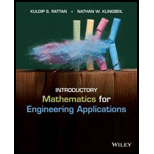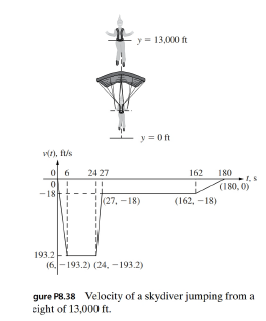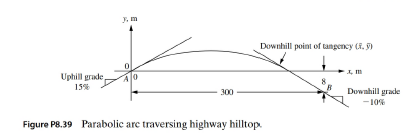
Concept explainers
A proposed highway traverses a hill-top bounded by uphill and downhill grades of 15% and -10%, respectively. These grades pass through benchmarks A and B located as shown in Fig. P8.39.
With the origin of the coordinate axes (x, y) set at benchmark A, the engineer has defined the hilltop segment of the

highway by a parabolic arc
(a) Find the slope of the line for the up-hill grade and the value of b for the parabolic arc.
(b) Find the equation of the line
(c) Given that at the downhill point of tangency

determine the point of tangency
(d) Find the equation of the parabolic arc.
Want to see the full answer?
Check out a sample textbook solution
Chapter 8 Solutions
Introductory Mathematics for Engineering Applications
Additional Math Textbook Solutions
A First Course in Probability (10th Edition)
Pre-Algebra Student Edition
Probability And Statistical Inference (10th Edition)
Calculus: Early Transcendentals (2nd Edition)
- Temperature measurements are based on the transfer of heat between the sensor of a measuring device (such as an ordinary thermometer or the gasket of a thermocouple) and the medium whose temperature is to be measured. Once the sensor or thermometer is brought into contact with the medium, the sensor quickly receives (or loses, if warmer) heat and reaches thermal equilibrium with the medium. At that point the medium and the sensor are at the same temperature. The time required for thermal equilibrium to be established can vary from a fraction of a second to several minutes. Due to its small size and high conductivity it can be assumed that the sensor is at a uniform temperature at all times, and Newton's cooling law is applicable. Thermocouples are commonly used to measure the temperature of gas streams. The characteristics of the thermocouple junction and the gas stream are such that λ = hA/mc 0.02s-1. Initially, the thermocouple junction is at a temperature Ti and the gas stream at…arrow_forward3) Recall that the power set of a set A is the set of all subsets of A: PA = {S: SC A}. Prove the following proposition. АСВ РАСРВarrow_forwardA sequence X = (xn) is said to be a contractive sequence if there is a constant 0 < C < 1 so that for all n = N. - |Xn+1 − xn| ≤ C|Xn — Xn−1| -arrow_forward
- 3) Find the surface area of z -1≤ y ≤1 = 1 + x + y + x2 over the rectangle −2 ≤ x ≤ 1 and - Solution: TYPE YOUR SOLUTION HERE! ALSO: Generate a plot of the surface in Mathematica and include that plot in your solution!arrow_forward7. Walkabout. Does this graph have an Euler circuit? If so, find one. If not, explain why not.arrow_forwardBelow, let A, B, and C be sets. 1) Prove (AUB) nC = (ANC) U (BNC).arrow_forward
- A sequence X = (xn) is said to be a contractive sequence if there is a constant 0 < C < 1 so that for all n = N. - |Xn+1 − xn| ≤ C|Xn — Xn−1| -arrow_forward1) Suppose continuous random variable X has sample space S = [1, ∞) and a pdf of the form f(x) = Ce-(2-1)/2. What is the expected value of X?arrow_forwardA sequence X = (xn) is said to be a contractive sequence if there is a constant 0 < C < 1 so that for all n = N. - |Xn+1 − xn| ≤ C|Xn — Xn−1| -arrow_forward
- Algebra & Trigonometry with Analytic GeometryAlgebraISBN:9781133382119Author:SwokowskiPublisher:Cengage
 Trigonometry (MindTap Course List)TrigonometryISBN:9781305652224Author:Charles P. McKeague, Mark D. TurnerPublisher:Cengage Learning
Trigonometry (MindTap Course List)TrigonometryISBN:9781305652224Author:Charles P. McKeague, Mark D. TurnerPublisher:Cengage Learning Trigonometry (MindTap Course List)TrigonometryISBN:9781337278461Author:Ron LarsonPublisher:Cengage Learning
Trigonometry (MindTap Course List)TrigonometryISBN:9781337278461Author:Ron LarsonPublisher:Cengage Learning  Mathematics For Machine TechnologyAdvanced MathISBN:9781337798310Author:Peterson, John.Publisher:Cengage Learning,
Mathematics For Machine TechnologyAdvanced MathISBN:9781337798310Author:Peterson, John.Publisher:Cengage Learning, Algebra and Trigonometry (MindTap Course List)AlgebraISBN:9781305071742Author:James Stewart, Lothar Redlin, Saleem WatsonPublisher:Cengage Learning
Algebra and Trigonometry (MindTap Course List)AlgebraISBN:9781305071742Author:James Stewart, Lothar Redlin, Saleem WatsonPublisher:Cengage Learning Elementary Geometry For College Students, 7eGeometryISBN:9781337614085Author:Alexander, Daniel C.; Koeberlein, Geralyn M.Publisher:Cengage,
Elementary Geometry For College Students, 7eGeometryISBN:9781337614085Author:Alexander, Daniel C.; Koeberlein, Geralyn M.Publisher:Cengage,





